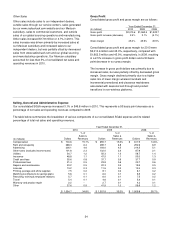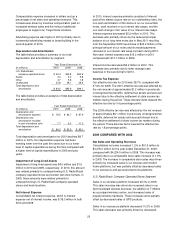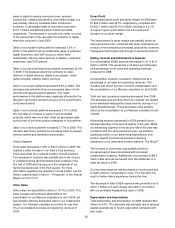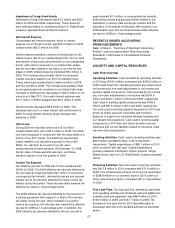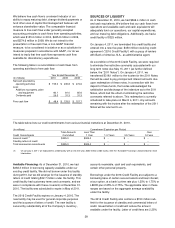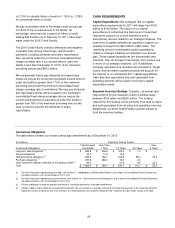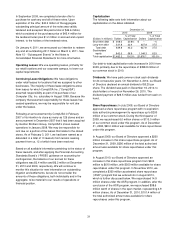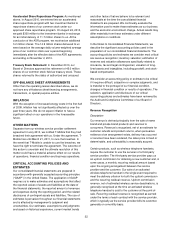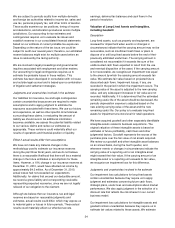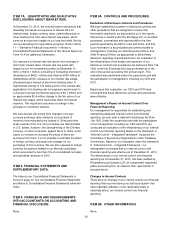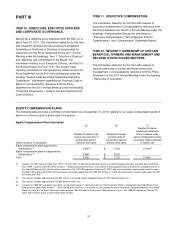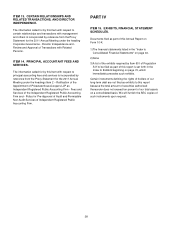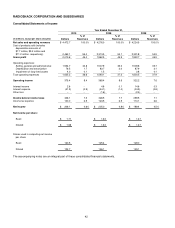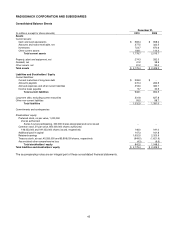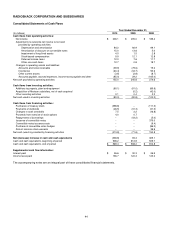Radio Shack 2010 Annual Report Download - page 44
Download and view the complete annual report
Please find page 44 of the 2010 Radio Shack annual report below. You can navigate through the pages in the report by either clicking on the pages listed below, or by using the keyword search tool below to find specific information within the annual report.34
We are subject to periodic audits from multiple domestic
and foreign tax authorities related to income tax, sales and
use tax, personal property tax, and other forms of taxation.
These audits examine our tax positions, timing of income
and deductions, and allocation procedures across multiple
jurisdictions. Our accounting for tax estimates and
contingencies requires us to evaluate tax issues and
establish reserves in our consolidated financial statements
based on our estimate of current probable tax exposures.
Depending on the nature of the tax issue, we could be
subject to audit over several years; therefore, our estimated
reserve balances might exist for multiple years before an
issue is resolved by the taxing authority.
We are involved in legal proceedings and governmental
inquiries associated with employment and other matters.
Our accounting for legal contingencies requires us to
estimate the probable losses in these matters. This
estimate has been developed in consultation with in-house
and outside legal counsel and is based upon a combination
of litigation and settlement strategies.
Judgments and uncertainties involved in the estimate
Our liabilities for insurance, tax and legal contingencies
contain uncertainties because we are required to make
assumptions and to apply judgment to estimate the
exposures associated with these items. We use our history
and experience, as well as other specific circumstances
surrounding these claims, in evaluating the amount of
liability we should record. As additional information
becomes available, we assess the potential liability related
to our various claims and revise our estimates as
appropriate. These revisions could materially affect our
results of operations and financial position or liquidity.
Effect if actual results differ from assumptions
We have not made any material changes in the
methodology used to estimate our insurance reserves
during the past three fiscal years, and we do not believe
there is a reasonable likelihood that there will be a material
change in the future estimates or assumptions for these
items. However, a 10% change in our insurance reserves at
December 31, 2010, would have affected net income by
approximately $4.3 million. As of December 31, 2010,
actual losses had not exceeded our expectations.
Additionally, for claims that exceed our deductible amount,
we record a gross liability and corresponding receivable
representing expected recoveries, since we are not legally
relieved of our obligation to the claimant.
Although we believe that our insurance, tax and legal
reserves are based on reasonable judgments and
estimates, actual results could differ, which may expose us
to material gains or losses in future periods. These actual
results could materially affect our effective tax rate,
earnings, deferred tax balances and cash flows in the
period of resolution.
Valuation of Long-Lived Assets and Intangibles,
including Goodwill
Description
Long-lived assets, such as property and equipment, are
reviewed for impairment when events or changes in
circumstances indicate that the carrying amount may not be
recoverable, such as insufficient cash flows or plans to
dispose of or sell long-lived assets before the end of their
previously estimated useful lives. The carrying amount is
considered not recoverable if it exceeds the sum of the
undiscounted cash flows expected to result from the use
and eventual disposition of the asset. If the carrying amount
is not recoverable, we recognize an impairment loss equal
to the amount by which the carrying amount exceeds fair
value. We estimate fair value based on projected future
discounted cash flows. Impairment losses, if any, are
recorded in the period in which the impairment occurs. The
carrying value of the asset is adjusted to the new carrying
value, and any subsequent increases in fair value are not
recorded. Additionally, if it is determined that the estimated
remaining useful life of the asset should be decreased, the
periodic depreciation expense is adjusted based on the
new existing carrying value of the asset and the new
remaining useful life. Our policy is to evaluate long-lived
assets for impairment at a store level for retail operations.
We have acquired goodwill and other separately identifiable
intangible assets related to business acquisitions. The
original valuation of these intangible assets is based on
estimates of future profitability, cash flows and other
judgmental factors. Goodwill represents the excess of the
purchase price over the fair value of net assets acquired.
We review our goodwill and other intangible asset balances
on an annual basis, during the fourth quarter, and
whenever events or changes in circumstances indicate the
carrying value of a reporting unit or an intangible asset
might exceed their fair value. If the carrying amount of an
intangible asset or a reporting unit exceeds its fair value,
we recognize an impairment loss for this difference.
Judgments and uncertainties involved in the estimate
Our impairment loss calculations for long-lived assets
contain uncertainties because they require us to apply
judgment and estimates concerning future cash flows,
strategic plans, useful lives and assumptions about market
performance. We also apply judgment in the selection of a
discount rate that reflects the risk inherent in our current
business model.
Our impairment loss calculations for intangible assets and
goodwill contain uncertainties because they require us to
estimate fair values related to these assets. We estimate


